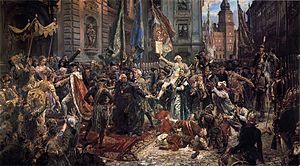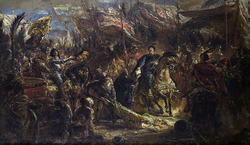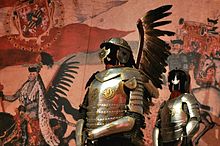Those who don’t know the history are destined to repeat it.
Edmund Burke
History doesn’t repeat itself, but does rhyme.
Mark Twain
Nescire autem quid antequam natus sis acciderit, id est semper esse puerum.
To be ignorant of what occurred before you were born is to remain always a child.
Cicero
The year was 1789 and in the United States, 13 colonies just ratified the Constitution. It was and still is a monumental document, which this country is very proud of.
Unbeknownst to most of the people, in the other hemisphere, another country was doing similar work. Poland was working on the constitution, which was adopted by Sejm (corresponding to American Congress) on May 3rd, 1791. British historian Norman Davies described this document as “the first constitution of this type in Europe” and the other historians call it the world’s second-oldest codified national constitution after the US Constitution.

American and Polish geopolitical realities were quite different, but the goal was the same. The current political systems were grossly outdated and the time came to replace them with new ones, positioning both countries for years to come.
Poland in the 16-17th century was one of the biggest powers in Europe. Our country was stretched out from the Baltic Sea to the Black Sea. The Polish king Jan Sobieski was a famous military commander, fighting the Swedish invasion from the North. His skills were widely respected and when Turks under Kara Mustafa, invading Europe from the East, threatened Vienna, Germans and Austrians asked him for help. In 1683, unified forces of 81,000 soldiers under the Polish King mounted a surprise attack on 130,000 of the Turks. By the end of the day, a decisive attack was carried out by Polish hussars. These were heavy fighters on huge horses. Their armor was supplemented with wings with impressive feathers. Running down the hill on the outskirts of Vienna, they created a terrifying whirl, wreaking havoc among lightly armored Turks. The King led the charge himself. Soon the Turks were in disarray and their resistance was broken. When Sobieski entered Kara Mustafa’s tent, it was empty. And this was an end to Turkish expansion to the West and de facto an end to the Ottoman Empire. King Sobieski was heralded as a Savior of Western European Civilization.


For Poland, however, it was mostly downhill ever since. The king’s power gradually became more and more limited. By the same token, the power of nobles was increasing. Liberum veto (rule allowing one participant to break any agreement) was a nightmare to a parliamentary process. Anarchy was rampant, and the country was effectively ruled by powerful landowners.
Winds were changing in Europe. In the French Revolution in 1789, ideas of Enlightenment and English moral and legal principles were gaining influence. Ideas of checks and balances with separation of powers were implemented in the United States and then a few years later in Poland. The Polish Constitution preceded the French Constitution by several months. Poland was established as a constitutional monarchy with an electable king. All peasants, including all glebae adscripti, “attached” to the land of latifundia owners, were put under the protection of the government, ending centuries long absolute power by their owners.
Our mighty neighbours were watching. Their medieval monarchic systems led by Kaiser in Germany, Emperor in Austria and Tsar in Russia wouldn’t even think of exporting new ideas to their countries. Therefore Poland was invaded by them, resulting in three partitions of our country. First in 1772, then in 1793 and completed in 1795, three big imperial powers ended our dream of self-governance and independence. Poland was no more. The first constitutional democracy in Europe was squelched by its powerful neighbours.
So when we look at present political conditions in the world, territorial appetites shown by powerful countries are nothing new. Intimidation by political, economic and military means are used to preserve power structure, gain new resources and not the last to divert attention from problems at home. And everybody does it. The same was in the Middle Ages and Antiquity. Human nature didn’t change much. And you cannot be an independent country unless you can defend yourself. We were reminded of that over and over again in our history.


